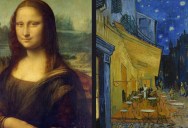5 Famous Paintings That Hold Secret Messages
It’s fascinating to think about how forward-thinking some of the great artists of history were. Because some legendary artists not only created amazing pieces of work that have stood the test of time, but they also hid secret messages and symbols in their creations.
Here are five examples of famous paintings that hold secret messages.
1. Clara Peeters – “Still Life with Cheeses, Almonds and Pretzels” (circa 1615)
Peeters specialized in still-life paintings with food and this is one of her best-known works.
It may look like a simple scene, but if you look closely at the lid on top of the jug in the center of the painting, you’ll see that Peeters painted a reflection of her face.
Go ahead and zoom in and take a look!

Photo Credit: Wikipedia
2. Michelangelo – Frescoes on the Vault of the Sistine Chapel (1508-1512)
If you’ve ever been lucky enough to visit Vatican City and stare in amazement at the vault of the Sistine Chapel, you know that you could spend a lifetime studying the paintings Michelangelo created there…but the artist’s work has some hidden meanings.
Here’s one example: behind the Cumaean Sibyl, one of the cherubs is sticking his thumb between his middle and index finger. This gesture dates back to the ancient Romans and is seen as obscene and is the equivalent of giving someone the middle finger.
It’s believed that Michelangelo knew that people wouldn’t be able to see this particular detail from the floor of the room, but that the artist might have thought it was funny to sneak the gesture into his work.

Photo Credit: Michelangelo Gallery
3. Sandro Botticelli – “Primavera” (late 1470s or early 1480s)
“Primavera” is regarded as the first large-scale painting made in Renaissance Florence and that Botticelli included over 500 individual plants in this piece. These plants can be classified as over 200 different species and some people think that all of these species flourished during springtime in Florence in the 15th century.

Photo Credit: Wikipedia
4. Leonardo da Vinci – “Mona Lisa” (1503)
Arguably the most famous painting of all time, scholars are divided over the existence of secret meanings in Leonardo da Vinci’s “Mona Lisa.”
But Silvano Vinceti, the President of Italy’s National Committee for Cultural Heritage, believes that there are cryptic messages in the painting.
Vinceti studied high-resolution images of the “Mona Lisa” and claims that there are letters and numbers in the woman’s eyes, including an “LV” which Vicenti and his team believe was da Vinci’s way of claiming his right to the painting.

Photo Credit: Wikipedia
5. Vincent van Gogh – “Café Terrace at Night” (1888)
Is this painting by Vincent van Gogh his version of “The Last Supper“?
According to a van Gogh expert named Jared Baxter, the central figure in the background who is standing and is surrounded by 12 people represents Jesus and a figure to the left slipping away into the darkness represents Judas.
There are also several crucifixes hidden throughout the painting, including one above the Jesus character’s head.

Photo Credit: Wikipedia
Now you know! Good luck delving into these mysteries!

Sign up to get our BEST stories of the week straight to your inbox.




